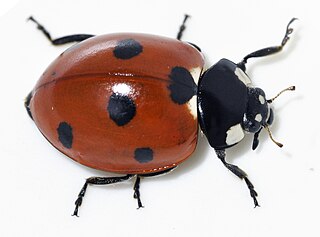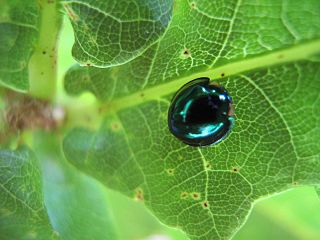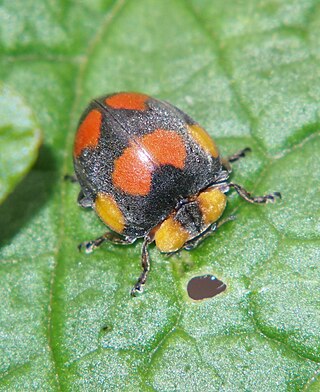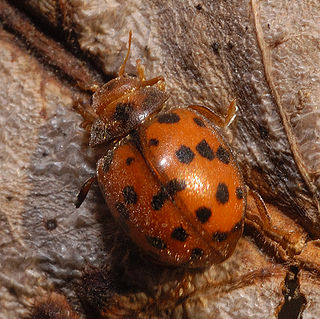
Harmonia axyridis is a large lady beetle or ladybug species that is most commonly known as the harlequin, Asian, or multicoloured Asian lady beetle. This is one of the most variable species in the world, with an exceptionally wide range of colour forms. It is native to eastern Asia, but has been artificially introduced to North America and Europe to control aphids and scale insects. It is now common, well known, and spreading in those regions, and has also established in Africa and widely across South America. This species is conspicuous in North America, where it may locally be known as the Halloween beetle, as it often invades homes during October to overwinter.
Coccinella novemnotata, the nine-spotted ladybug or nine-spotted lady beetle or C9, is a species of ladybug in the family Coccinellidae native to North America. This beetle was once ubiquitous across the continent but it experienced a sharp and drastic decline around the 1960’s. As a rare species, the nine-spotted ladybug has received much attention from researchers who wish to understand the causes of its decline and restore the population of this charismatic beetle to benefit from their aphidophagous nature as biocontrol agents in agriculture.

Coccinella septempunctata, the common ladybug, the seven-spot ladybird, is a carnivorous beetle native to the Old World and is the most common ladybird in Europe. The beetle is also found in North America, Central and Eastern Asia and regions with a temperate climate. Its elytra are of a red colour, but each punctuated with three black spots, with one further spot being spread over the junction of the two, making a total of seven spots, from which the species derives both its common and scientific names.

The Mexican bean beetle is a species of lady beetle that can be an agricultural pest. It is one of the few North American lady beetles that feed on plants rather than other insects. It is found throughout Mexico and the eastern United States, and is abundant in the wetter and more heavily irrigated areas west of the Rocky Mountains. It does not tolerate extremely dry areas.

Coccinellidae is a widespread family of small beetles. They are commonly known as ladybugs in North America and ladybirds in the United Kingdom; "lady" refers to mother Mary. Entomologists use the names ladybird beetles or lady beetles to avoid confusion with true bugs. The more than 6,000 described species have a global distribution and are found in a variety of habitats. They are oval beetles with a domed back and flat underside. Many of the species have conspicuous aposematic (warning) colours and patterns, such as red with black spots, that warn potential predators that they taste bad.

Halmus chalybeus, commonly known as the steelblue ladybird, is a species of ladybird native to Australia. It has a rounded appearance with an iridescent blue/green colouration and is a predator of other insects. It was introduced to New Zealand from Australia in 1899 and 1905 to control black scale and blue gum scale on citrus trees, where it is now common in northern regions. It has also been recorded eating San Jose scale. They are about 3–4 mm long.

Coccinella transversalis, commonly known as the transverse ladybird or transverse lady beetle, is a species of ladybird beetle found from India across southern and southeastern Asia to Malesia and Australia. It is not to be confused with Coccinella transversoguttata, a widespread species in Europe and North America also known as the transverse ladybird. The alternative vernacular of small transverse ladybird may be used for C. transversalis in instances where these two species are discussed together.

Henosepilachna vigintisexpunctata, common name twenty-six-spotted potato ladybird, is a ladybird species.

Coleomegilla maculata, commonly known as the spotted lady beetle, pink spotted lady beetle or twelve-spotted lady beetle, is a large coccinellid beetle native to North America. The adults and larvae feed primarily on aphids and the species has been used as a biological control agent. Based on name connotation and to avoid confusion with other species also called "spotted ladybeetle", spotted pink ladybeetle is probably the most appropriate common name for this species.

The Epilachninae are a subfamily of the family of lady beetles, the Coccinellidae, in the order Coleoptera. Superficially, they look much like other ladybirds in the larger subfamily Coccinellinae, but they differ importantly in their biology, in that the members of the subfamily are largely or completely leaf-feeding herbivores rather than being predators. Accordingly, several members of the subfamily are crop pests, and sometimes cause locally serious crop losses.

Papuaepilachna guttatopustulata, the large leaf-eating ladybird, is a species of ladybird, formerly in the genus Henosepilachna endemic to parts of Australasia, specifically New South Wales, Queensland, the Bismarck Archipelago, New Guinea, New Hebrides and Solomon Islands.

Subcoccinella vigintiquatuorpunctata is a beetle in the family Coccinellidae. It is the only member of the genus Subcoccinella. It has the typical, almost semi-spherical, ladybird shape and is patterned with spots. However it differs from many of the well-known ladybirds in being neither smooth and shiny nor an eater of aphids: the wing-cases look velvety and it eats fungal moulds on plants.

Chnootriba elaterii, the melon ladybird beetle, is a phytophagous ladybird species found in southern Europe, Africa and western Asia. It feeds mainly on squirting cucumber, but also on other cultivated or spontaneous Cucurbitaceae plants.
Henosepilachna vigintioctomaculata is a species of beetle in the family Coccinellidae. It is commonly known as the 28-spotted potato ladybird, a name also used for the closely related species, Henosepilachna vigintioctopunctata.

Henosepilachna is a genus of beetle in the family Coccinellidae, including several pest species, such as the 28-spotted potato ladybird.

Epilachna is a genus of beetle in the family Coccinellidae, including several pest species, such as the Mexican bean beetle.

Henosepilachna argus, common name bryony ladybird, is a species of beetle in the family Coccinellidae.

Henosepilachna septima, is a species of lady beetle found in Vietnam, Indonesia, Malaysia, India, Sri Lanka and Pakistan.
Aola Mary Richards was a New Zealand entomologist specialising in the study of New Zealand and Australian cave crickets, or wētā (Rhaphidophoridae), and Australian ladybird beetles (Coccinellidae). She was the first New Zealand woman to gain a PhD in biology.

Adira is a genus of beetles in the family Coccinellidae. It was first described by Gordon & Almeida, 1986



















